Lecture Notes Editorial Policies
Lecture Notes in Statistics provides a format for the
informal and quick publication of monographs, case
studies, and workshops of theoretical or applied
importance. Thus, in some instances, proofs may be
merely outlined and results presented which will later
be published in a different form.
Publication of the Lecture Notes is intended as a ser
vice to the international statistical community, in that
a commercial publisher, Springer-Verlag, can provide
efficient distribution of documents that would other
wise have a restricted readership. Once published and
copyrighted, they can be documented and discussed in
the scientific literature.
Lecture Notes are reprinted photographically from the
copy delivered in camera-ready form by the author or
editor. Springer-Verlag provides technical instructions
for the preparation of manuscripts. Volumes should be
no less than 100 pages and preferably no more than
400 pages. A subject index is expected for authored
but not edited volumes. Proposals for volumes should
be sent to one of the series editors or addressed to
"Statistics Editor" at Springer-Verlag in New York.
Authors of monographs receive 50 free copies of their
book. Editors receive 50 free copies and are responsi
ble for distributing them to contributors. Authors, edi
tors, and contributors may purchase additional copies
at the publisher's discount. No reprints of individual
contributions will be supplied and no royalties are
paid on Lecture Notes volumes. Springer-Verlag
secures the copyright for each volume.
Series Editors:
Professor P. Bickel
Department of Statistics
University of California
Berkeley, California 94720
USA
Professor P. Diggle
Department of Mathematics
Lancaster University
Lancaster LA I 4 YL
England
Professor S. Fienberg
Department of Statistics
Carnegie Mellon University
Pittsburgh, Pennsylvania 15213
USA
Professor K. Krickeberg
3 Rue de L'Estrapade
75005 Paris
France
Professor 1. 01kin
Department of Statistics
Stanford University
Stanford, California 94305
USA
Professor N. Wermuth
Department of Psychology
Johannes Gutenberg University
Postfach 3980
D-6500 Mainz
Germany
Professor S. Zeger
Department of Biostatistics
The Johns Hopkins University
615 N. Wolfe Street
Baltimore, Maryland 21205-2103
USA
�
Lecture Notes in Statistics
Edited by P. Bickel, P. Diggle, S. Fienberg, K. Krickeberg,
I. OIkin, N. Wermuth, and S. Zeger
174
�
Springer
Science+ Business
Media, LLC
�
Yasuko Chikuse
Statistics on Special Manifolds
Springer
�
Yasuko Chikuse
Faculty of Engineering
Kagawa University
2217-20 Hayashi-cho
Takamatsu, Kagawa
Japan
chikuse@eng.kagawa-u.ac.jp
Library of Congress Cataloging-in-Publication Data
Chikuse, Yasuko.
Statistics on special manifolds / Yasuko Chikuse.
p. cm. - (Lecture notes in statistics; 174)
Includes bibliographical references and index.
1. Manifolds (Mathematics) 2. Mathematical statistics. I. Title. II. Lecture notes in
statistics (Springer-Science+Business Media, LLC) ; 174.
QA613 .C48
516.07 - dc21
2002
2002042668
ISBN 978-0-387-00160-9
DOI 10.1007/978-0-387-21540-2
ISBN 978-0-387-21540-2 (eBook)
© 2003 Springer Science+Business Media New York
Originally published by Springer-Verlag New York, Inc in 2003
AU rights reserved. This work may not be translated or copied in whole or in part without the written
permission of the publisher (Springer-Science+ Business Media, LLC ), except for brief
excerpts in connection with reviews or scholarly analysis. Use in connection with any form of
information storage and retrieval, electronic adaptation, computer software, or by similar or
dissimilar methodology now known or hereafter developed is forbidden.
The use in this publication of trade names, trademarks, service marks, and similar terms, even if
they are not identified as such, is not to be taken as an expression of opinion as to whether or not
they are subject to proprietary rights.
987 654 3 2 1
Typesetting: Pages created by the author using a Springer T EX macro package.
�
To my parents
�
Preface
The special manifolds of interest in this book are the Stiefel manifold and the
Grassmann manifold. Formally, the Stiefel manifold Vk,m is the space of k
frames in the m-dimensional real Euclidean space Rm, represented by the set
of m x k matrices X such that X' X = Ik, where Ik is the k x k identity matrix,
and the Grassmann manifold Gk,m-k is the space of k-planes (k-dimensional
hyperplanes) in Rm. We see that the manifold Pk,m-k of m x m orthogonal
projection matrices idempotent of rank k corresponds uniquely to Gk,m-k. This
book is concerned with statistical analysis on the manifolds Vk,m and Pk,m-k
as statistical sample spaces consisting of matrices. The discussion is carried out
on the real spaces so that scalars, vectors, and matrices treated in this book
are all real, unless explicitly stated otherwise.
For the special case k = 1, the observations from V1,m and G1,m-l are
regarded as directed vectors on a unit sphere and as undirected axes or lines,
respectively. There exists a large literature of applications of directional statis
tics and its statistical analysis, mostly occurring for m = 2 or 3 in practice,
in the Earth (or Geological) Sciences, Astrophysics, Medicine, Biology, Meteo
rology, Animal Behavior, and many other fields. Examples of observations on
the general Grassmann manifold Gk,m-k arise in the signal processing of radar
with m elements observing k targets. The Grassmann manifold is a rather new
subject treated as a statistical sample space, and the development of statistical
analysis on the Grassmann manifold, which is one of the purposes of this book,
must make some contributions to the study in the related sciences.
This book is designed as a reference book for both theoretical and applied
statisticians. The book will also be used as a textbook for a graduate course in
multivariate analysis for students who specialize in mathematical statistics or
multivariate analysis. I may assume that the reader is familiar with the usual
theory of univariate statistics and has a thorough background in mathematics,
in particular, a knowledge of multivariate calculation techniques. To make the
book self-contained, a brief review of those aspects and other related topics is
given in Chapter 1 and Appendices A and B. The reader may already know the
usual theory of multivariate analysis on the real Euclidean space and intend
�
viii
Preface
to deepen or broaden the research area to the one treated in this book, that
is, statistics on special manifolds, which is not treated in general textbooks of
multivariate analysis.
Chapters 1 to 3 are concerned with fundamental statistical and mathemat
ical properties of the special manifolds Vk,m and Pk,m-k.
Chapter 1 presents fundamental material which may be helpful for reading
the main part of the book: the backgrounds of the special manifolds, exam
ples of our orientation statistics in practical problems, and some multivariate
calculation techniques and matrix-variate distributions.
Chapter 2 discusses population distributions, uniform and non-uniform,
on the special manifolds. Among those distributions, the matrix Langevin dis
tributions defined on the two manifolds will be used for most of the statistical
analyses treated in later chapters. Chapter 2 also looks at a method to generate
some families of non-uniform distributions, that is, the distributions of the ori
entation and the orthogonal projection matrix of a random rectangular matrix,
and further suggests some simulation methods for generating pseudo-random
matrices on the manifolds.
Chapter 3 deals with the decomposition of the special manifolds, deriv
ing various types of decompositions (or transformations) of random matrices
and the corresponding decompositions of the invariant measures constructed in
Chapter 1 (or Jacobians of the transformations). The results are not only of
theoretical interest in themselves, but they are also of practical use for solving
some distributional and inferential problems.
In Chapter 4, we treat some distributional problems. The decompositions
obtained in Chapter 3 are used to derive various distributional results and to
introduce general families of distributions on the special manifolds. We derive
various sampling distributions for the sample matrix sums, which are sufficient
statistics, taken from the matrix Langevin distributions on the two manifolds.
The forms of the sampling distributions are expressed in the integral forms
involving hypergeometric functions with matrix arguments, which seem to be
intractable. The hypergeometric functions with matrix arguments involved in
inferential and distributional problems will be asymptotically evaluated and
asymptotic analyses will be carried out for three cases, that is, for large sample
size, for large concentration, and for high dimension, in Chapters 6, 7, and 8,
respectively.
Chapter 5 develops the theory of the statistical inference on the parameters
of the matrix Langevin distributions on the special manifolds. The problems
of estimation and tests for hypotheses of the parameters are dealt with by
the Fisher (profile) scoring methods. These solutions are given in terms of
hypergeometric functions with matrix arguments and will be approximately
�
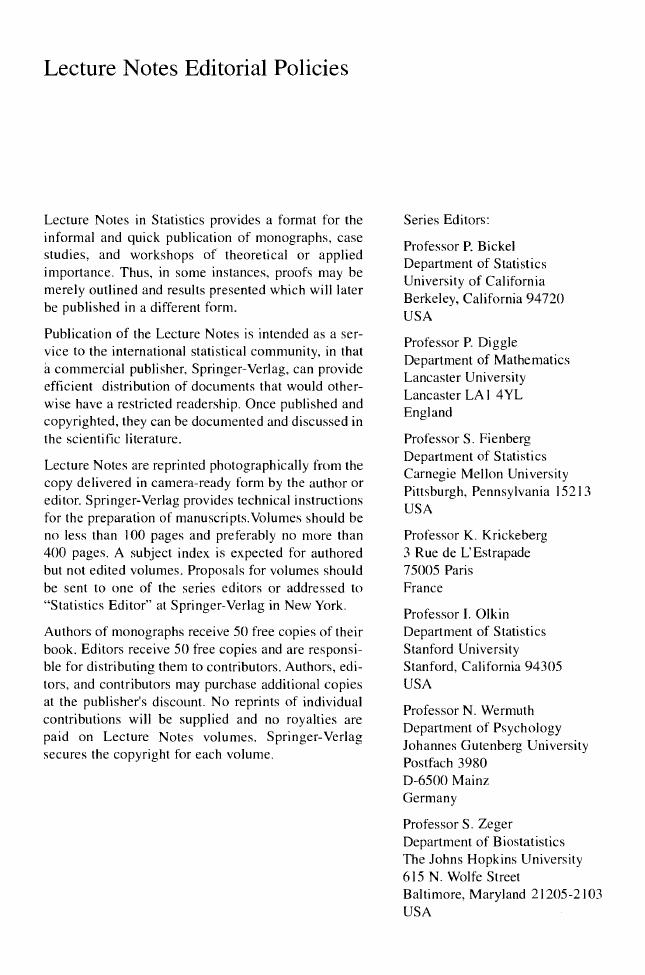


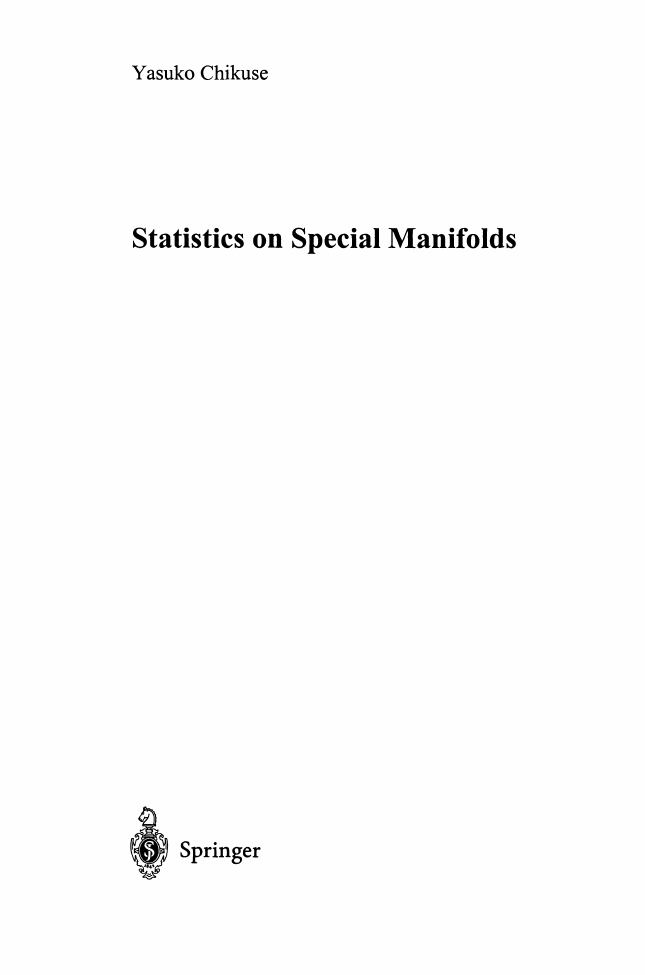
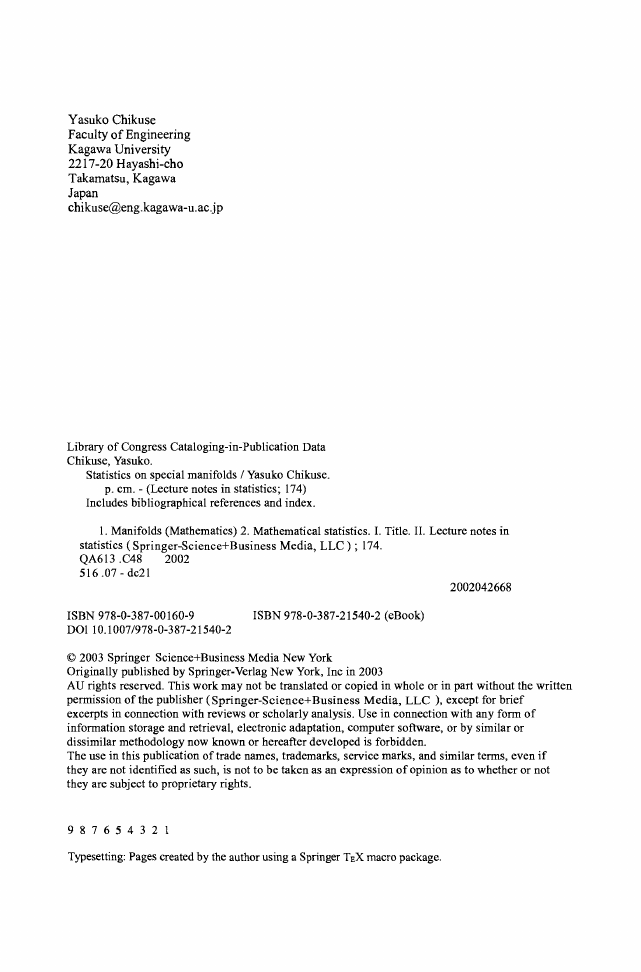

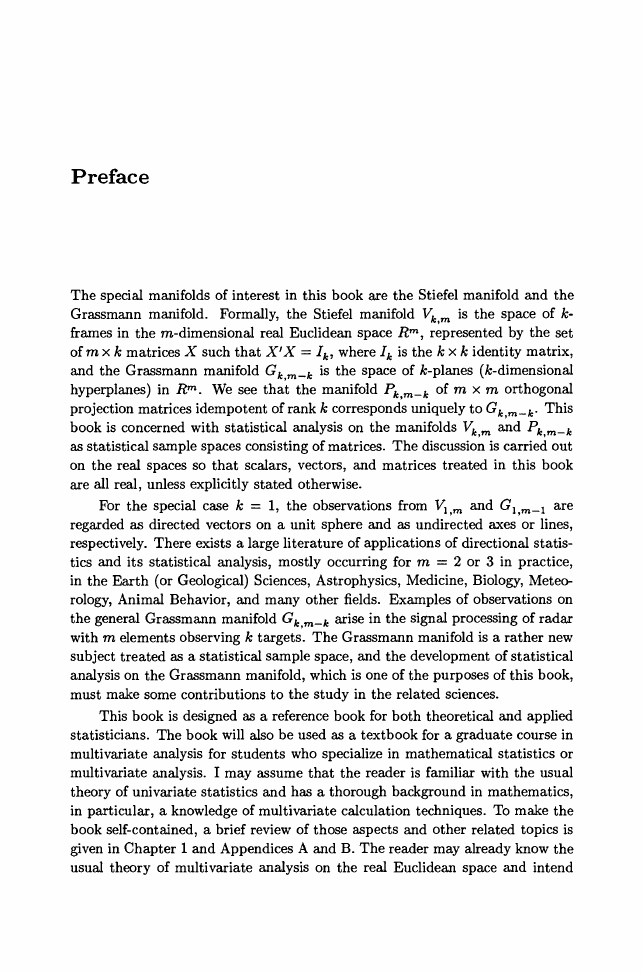
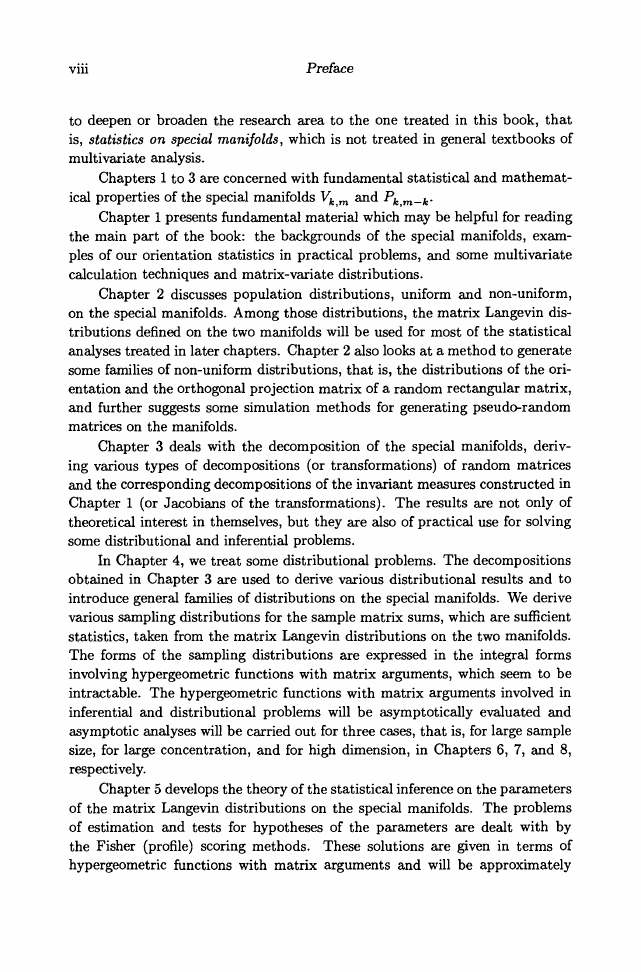








 2023年江西萍乡中考道德与法治真题及答案.doc
2023年江西萍乡中考道德与法治真题及答案.doc 2012年重庆南川中考生物真题及答案.doc
2012年重庆南川中考生物真题及答案.doc 2013年江西师范大学地理学综合及文艺理论基础考研真题.doc
2013年江西师范大学地理学综合及文艺理论基础考研真题.doc 2020年四川甘孜小升初语文真题及答案I卷.doc
2020年四川甘孜小升初语文真题及答案I卷.doc 2020年注册岩土工程师专业基础考试真题及答案.doc
2020年注册岩土工程师专业基础考试真题及答案.doc 2023-2024学年福建省厦门市九年级上学期数学月考试题及答案.doc
2023-2024学年福建省厦门市九年级上学期数学月考试题及答案.doc 2021-2022学年辽宁省沈阳市大东区九年级上学期语文期末试题及答案.doc
2021-2022学年辽宁省沈阳市大东区九年级上学期语文期末试题及答案.doc 2022-2023学年北京东城区初三第一学期物理期末试卷及答案.doc
2022-2023学年北京东城区初三第一学期物理期末试卷及答案.doc 2018上半年江西教师资格初中地理学科知识与教学能力真题及答案.doc
2018上半年江西教师资格初中地理学科知识与教学能力真题及答案.doc 2012年河北国家公务员申论考试真题及答案-省级.doc
2012年河北国家公务员申论考试真题及答案-省级.doc 2020-2021学年江苏省扬州市江都区邵樊片九年级上学期数学第一次质量检测试题及答案.doc
2020-2021学年江苏省扬州市江都区邵樊片九年级上学期数学第一次质量检测试题及答案.doc 2022下半年黑龙江教师资格证中学综合素质真题及答案.doc
2022下半年黑龙江教师资格证中学综合素质真题及答案.doc